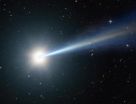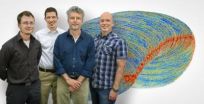(Press-News.org) University of Colorado Boulder astronomers targeting one of the brightest quasars glowing in the universe some 11 billion years ago say "sideline quasars" likely teamed up with it to heat abundant helium gas billions of years ago, preventing small galaxy formation.
CU-Boulder Professor Michael Shull and Research Associate David Syphers used the Hubble Space Telescope to look at the quasar -- the brilliant core of an active galaxy that acted as a "lighthouse" for the observations -- to better understand the conditions of the early universe. The scientists studied gaseous material between the telescope and the quasar with a $70 million ultraviolet spectrograph on Hubble designed by a team from CU-Boulder's Center for Astrophysics and Space Astronomy.
During a time known as the "helium reionization era" some 11 billion years ago, blasts of ionizing radiation from black holes believed to be seated in the cores of quasars stripped electrons from primeval helium atoms, said Shull. The initial ionization that charged up the helium gas in the universe is thought to have occurred sometime shortly after the Big Bang.
"We think 'sideline quasars' located out of the telescope's view reionized intergalactic helium gas from different directions, preventing it from gravitationally collapsing and forming new generations of stars," he said. Shull likened the early universe to a hunk of Swiss cheese, where quasars cleared out zones of neutral helium gas in the intergalactic medium that were then "pierced" by UV observations from the space telescope.
The results of the new study also indicate the helium reionization era of the universe appears to have occurred later than thought, said Shull, a professor in CU-Boulder's astrophysical and planetary sciences department. "We initially thought the helium reionization era took place about 12 billion years ago," said Shull. "But now we think it more likely occurred in the 11 to 10 billion-year range, which was a surprise."
A paper on the subject by Shull and Syphers was published online this week in the Astrophysical Journal.
The Cosmic Origins Spectrograph used for the quasar observations aboard Hubble was designed to probe the evolution of galaxies, stars and intergalactic matter. The COS team is led by CU Professor James Green of CASA and was installed on Hubble by astronauts during its final servicing mission in 2009. COS was built in an industrial partnership between CU and Ball Aerospace & Technologies Corp. of Boulder.
"While there are likely hundreds of millions of quasars in the universe, there are only a handful you can use for a study like this," said Shull. Quasars are nuclei in the center of active galaxies that have "gone haywire" because of supermassive black holes that gorged themselves in the cores, he said. "For our purposes, they are just a really bright background light that allows us to see to the edge of the universe, like a headlight shining through fog."
The universe is thought to have begun with the Big Bang that triggered a fireball of searing plasma that expanded and then become cool neutral gas at about 380,000 years, bringing on the "dark ages" when there was no light from stars or galaxies, said Shull. The dark ages were followed by a period of hydrogen reionization, then the formation of the first galaxies beginning about 13.5 billion years ago. The first galaxies era was followed by the rise of quasars some 2 billion years later, which led to the helium reionization era, he said.
The radiation from the huge quasars heated the gas to 20,000 to 40,000 degrees Fahrenheit in intergalactic realms of the early universe, said Shull. "It is important to understand that if the helium gas is heated during the epoch of galaxy formation, it makes it harder for proto-galaxies to hang on to the bulk of their gas. In a sense, it's like intergalactic global warming."
The team is using COS to probe the "fossil record" of gases in the universe, including a structure known as the "cosmic web" believed to be made of long, narrow filaments of galaxies and intergalactic gas separated by enormous voids. Scientists theorize that a single cosmic web filament may stretch for hundreds of millions of light years, an eye-popping number considering that a single light-year is about 5.9 trillion miles.
COS breaks light into its individual components -- similar to the way raindrops break sunlight into the colors of the rainbow -- and reveals information about the temperature, density, velocity, distance and chemical composition of galaxies, stars and gas clouds.
For the study, Shull and Syphers used 4.5 hours of data from Hubble observations of the quasar, which has a catalog name of HS1700+6416. While some astronomers define quasars as feeding black holes, "We don't know if these objects feed once, or feed several times," Shull said. They are thought to survive only a few million years or perhaps a few hundred million years, a brief blink in time compared to the age of the universe, he said.
"Our own Milky Way has a dormant black hole in its center," said Shull. "Who knows? Maybe our Milky Way used to be a quasar."
The first quasar, short for "quasi-stellar radio source," was discovered 50 years ago this month by Caltech astronomer Maarten Schmidt. The quasar he observed, 3C-273, is located roughly 2 billion years from Earth and is 40 times more luminous than an entire galaxy of 100 billion stars. That quasar is receding from Earth at 15 percent of the speed of light, with related winds blowing millions of miles per hour, said Shull.
INFORMATION:
-CU-
Editors: An artist's rendition of a quasar can be accessed at http://photography.colorado.edu/netpub/server.np?find&site=news&catalog=catalog&template=detail.np&field=itemid&op=matches&value=7471.
Contact:
Michael Shull
Jim Scott
CU-Boulder media relations
303-492-3114
Jim.Scott@colorado.edu
'Sideline quasars' helped to stifle early galaxy formation, says CU-Boulder study
2013-03-21
ELSE PRESS RELEASES FROM THIS DATE:
Reward linked to image is enough to activate brain's visual cortex
2013-03-21
Once rhesus monkeys learn to associate a picture with a reward, the reward by itself becomes enough to alter the activity in the monkeys' visual cortex. This finding was made by neurophysiologists Wim Vanduffel and John Arsenault (KU Leuven and Harvard Medical School) and American colleagues using functional brain scans and was published recently in the leading journal Neuron.
Our visual perception is not determined solely by retinal activity. Other factors also influence the processing of visual signals in the brain. "Selective attention is one such factor," says Professor ...
Do disruptions in brain communication have a role in autism?
2013-03-21
New Rochelle, NY, March 21, 2013—A new study of patterns of brain communication in toddlers with autism shows evidence of aberrant neural communication even at this relatively early stage of brain development. The results are presented in an article in Brain Connectivity, a bimonthly peer-reviewed journal from Mary Ann Liebert, Inc., publishers. The article is available free on the Brain Connectivity website at http://www.liebertpub.com/brain.
A team of researchers from The Netherlands (University Medical Center Utrecht and Utrecht University, Radboud University Nijmegen ...
Cancer drug shortages mean higher costs and greater risk for patients
2013-03-21
A national survey of health professionals showed that drug shortages are taking a heavy toll on cancer patients, forcing treatment changes and delays that for some patients meant worse outcomes, more therapy-related complications and higher costs. St. Jude Children's Research Hospital investigators played an important role in the study.
The survey queried oncology pharmacists and others involved in managing cancer drug shortages for academic medical centers, community hospitals and other cancer treatment facilities nationwide. Of the 243 individuals who completed the ...
Scientists identify gene that is consistently altered in obese individuals
2013-03-21
AUGUSTA, Ga. – Food and environment can chemically alter your gene function and scientists have identified a gene that is consistently altered in obesity.
The gene LY86 was among a group of 100 genes identified as likely contributors to obesity through genome-wide association studies comparing the DNA of thousands of obese and lean individuals, said Dr. Shaoyong Su, genetic epidemiologist at the Medical College of Georgia at Georgia Regents University.
Su looked at progressively larger groups of obese versus lean individuals and found LY86 consistently and highly chemically ...
Researchers' new method may sharpen microscopic images
2013-03-21
UT Dallas researchers are developing a new low-light imaging method that could improve a number of scientific applications, including the microscopic imaging of single molecules in cancer research.
Electrical engineering professor Dr. Raimund Ober and his team recently published their findings in the journal Nature Methods. In the journal, they describe a method which minimizes the deterioration of images that can occur with conventional imaging approaches.
"Any image you take of an object is translated by the camera into pixels with added electronic noise," Ober said. ...
Do I know you? Memory patterns help us recall the social webs we weave, finds new Cornell study
2013-03-21
ITHACA, N.Y. — With a dizzying number of ties in our social networks – that your Aunt Alice is a neighbor of Muhammad who is married to Natasha who is your wife's boss – it's a wonder we remember any of it. How do we keep track of the complexity? We cheat, says a Cornell University sociologist in Scientific Reports (March 21), a publication of Nature.
Study: http://www.nature.com/srep/2013/130321/srep01513/full/srep01513.html
Humans keep track of social information not by rote memorization but with simplifying rules, as you might remember a number sequence that always ...
Genetic risk strategies needed for young, black, female breast cancer patients, Moffitt study shows
2013-03-21
Researchers at Moffitt Cancer Center and colleagues in Canada have published study results focused on black women younger than 50, a population disproportionately afflicted with and dying from early-onset breast cancer compared to their white counterparts. The research published in the Jan. 16 issue of The Breast Journal.
Early-onset breast cancer has been associated with mutations in the BRCA1 and BRCA2 genes. These breast cancer predisposing genes were discovered almost 20 years ago and confer a lifetime risk of breast cancer of 60 to 70 percent, as well as a much higher ...
Berkeley Lab scientists read the cosmic writing on the wall
2013-03-21
Thanks to a supersensitive space telescope and some sophisticated supercomputing, scientists from the international Planck collaboration have made the closest reading yet of the most ancient story in our universe: the cosmic microwave background (CMB).
Today, the team released preliminary results based on the Planck observatory's first 15 months of data. Using supercomputers at the U.S. Department of Energy's (DOE) National Energy Research Scientific Computing Center (NERSC) Planck scientists have created the most detailed and accurate maps yet of the relic radiation ...
For the first time, recommendations offer guidance about incidental genetic findings
2013-03-21
Boston – In a highly anticipated report, landmark recommendations on the handling of incidental findings in clinical genome and exome sequencing are being issued from the American College of Medical Genetics and Genomics (ACMG). A report of the recommendations, led by Robert C. Green, MD, MPH, a medical geneticist at Brigham and Women's Hospital (BWH), outlines for the first time a minimum list of genetic conditions, genes and variants that laboratories performing clinical sequencing should seek and report to the physicians that ordered the testing -- regardless of the ...
European Guidance for the diagnosis & management of osteoporosis in postmenopausal women
2013-03-21
A new Guidance recently published by the European Society for Clinical and Economic Aspects of Osteoporosis (ESCEO) and the International Osteoporosis Foundation (IOF) reflects the most current advances in the diagnosis and management of osteoporosis, the 'silent disease' which affects up to one in two postmenopausal women.
"The serious impact of fragility fractures due to osteoporosis is vastly underestimated by many health care professionals," stated ESCEO President Professor Jean-Yves Reginster.
"Statistics clearly show that fragility fractures in older adults ...



